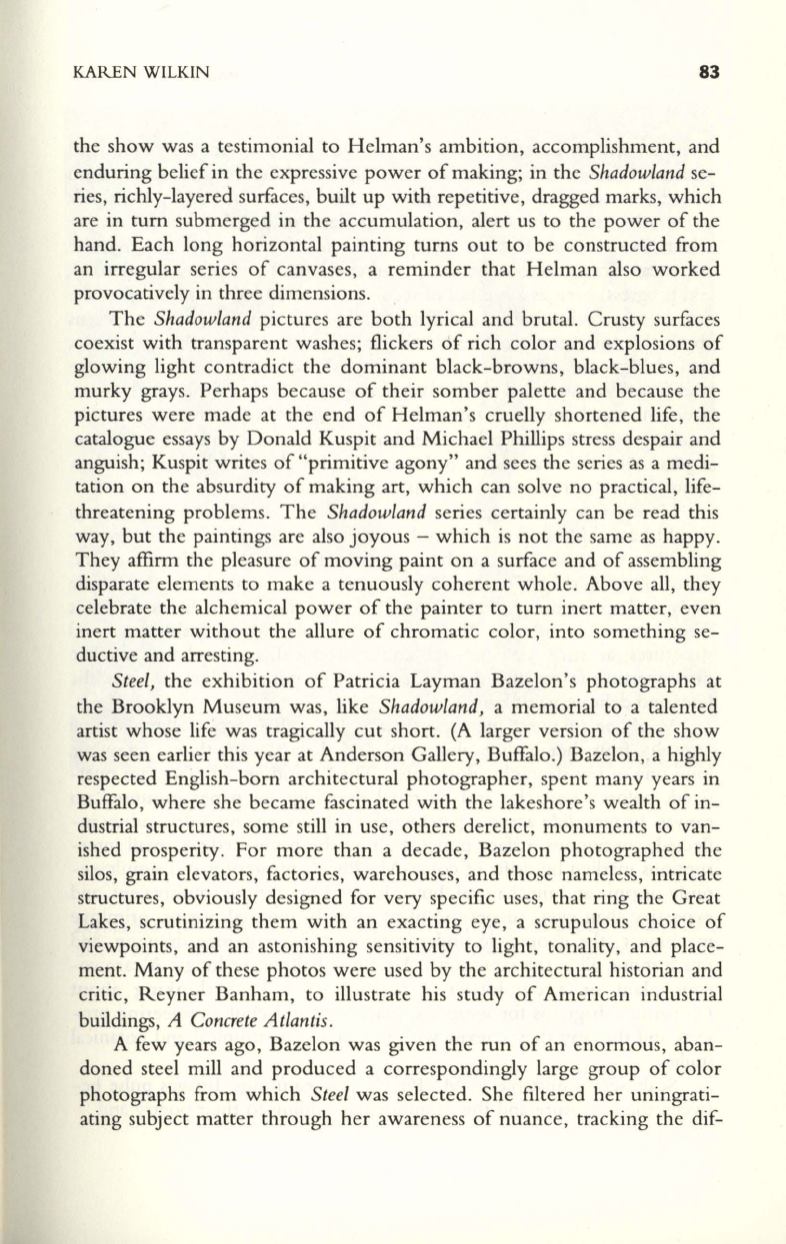
KAREN WILKIN
83
the show was a testimonial to Helman's ambition, accomplishment, and
enduring belief in the expressive power of making; in the
Shadowland
se–
ries, richly-layered surfaces, built up with repetitive, dragged marks, which
are in tum submerged in the accumulation, alert us to the power of the
hand. Each long horizontal painting turns out to be constructed from
an irregular series of canvases, a reminder that Helman also worked
provocatively in three dimensions.
The
Shadowland
pictures are both lyrical and brutal. Crusty surfaces
coexist with transparent washes; flickers of rich color and explosions of
glowing light contradict the dominant black-browns, black-blues, and
murky grays. Perhaps because of their somber palette and because the
pictures were made at the end of Helman's cruelly shortened life, the
catalogue essays by Donald Kuspit and Michael Phillips stress despair and
anguish; Kuspit writes of "primitive agony" and sees the series as a medi–
tation on the absurdity of making art, which can solve no practical, life–
threatening problems. The
Shadowland
series certainly can be read this
way, but the paintings are also joyous - which is not the same as happy.
They affirm the pleasure of moving paint on a surface and of assembling
disparate elements to make a tenuously coherent whole. Above all, they
celebrate the alchemical power of the painter to tum inert matter, even
inert matter without the allure of chromatic color, into something se–
ductive and arresting.
Steel,
the exhibition of Patricia Layman Bazelon's photographs at
the Brooklyn Museum was, like
Shadowland,
a memorial to a talented
artist whose life was tragically cut short. (A larger version of the show
was seen earlier this year at Anderson Gallery, Buffalo.) Bazelon, a highly
respected English-born architectural photographer, spent many years in
Buffalo, where she became fascinated with the lakeshore's wealth of in–
dustrial structures, some still in use, others derelict, monuments to van–
ished prosperity. For more than a decade, Bazelon photographed the
silos, grain elevators, factories, warehouses, and those nameless, intricate
structures, obviously designed for very specific uses, that ring the Great
Lakes, scrutinizing them with an exacting eye, a scrupulous choice of
viewpoints, and an astonishing sensitivity to light, tonality, and place–
ment. Many of these photos were used by the architectural historian and
critic, Reyner Banham, to illustrate his study of American industrial
buildings,
A Concrete Atlantis.
A few years ago, Bazelon was given the run of an enormous, aban–
doned steel mill and produced a correspondingly large group of color
photographs from which
Steel
was selected. She filtered her uningrati–
ating subject matter through her awareness of nuance, tracking the dif-


